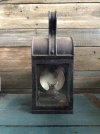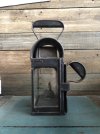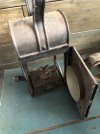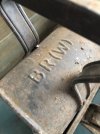-
Our booking engine at tickets.railforums.co.uk (powered by TrainSplit) helps support the running of the forum with every ticket purchase! Find out more and ask any questions/give us feedback in this thread!
You are using an out of date browser. It may not display this or other websites correctly.
You should upgrade or use an alternative browser.
You should upgrade or use an alternative browser.
Old lamp found in shed...what is it ?
- Thread starter homerdog7330
- Start date
Sponsor Post - registered members do not see these adverts; click here to register, or click here to log in
R
RailUK Forums
It's a hand-lamp, although not of a sort I've seen before. It's a bit odd in that it has glass in the sides, yet has a reflector to help throw light forward! I wonder if someone at some time has cut out the sides and added the glass for some reason?
You are correct that BR(W) means BR Western [Region] but the design of the lamp is much older. It runs on paraffin but check for corrosion of the fuel container first and always fill and light out of doors. (The burner assembly is lifted out for refilling purposes - the shaft and knurled knob adjusts the length of wick exposed and hence the size of the flame and is usually the part that fails to work in old lamps!)
You are correct that BR(W) means BR Western [Region] but the design of the lamp is much older. It runs on paraffin but check for corrosion of the fuel container first and always fill and light out of doors. (The burner assembly is lifted out for refilling purposes - the shaft and knurled knob adjusts the length of wick exposed and hence the size of the flame and is usually the part that fails to work in old lamps!)
Last edited:
homerdog7330
Member
It's a hand-lamp, although not of a sort I've seen before. It's a bit odd in that it has glass in the sides, yet has a reflector to help throw light forward! I wonder if someone at some time has cut out the sides and added the glass for some reason?
You are correct that BR(W) means BR Western [Region] but the design of the lamp is much older. It runs on paraffin but check for corrosion of the fuel container first and always fill and light out of doors. (The burner assembly is lifted out for refilling purposes - the shaft and knurled knob adjusts the length of wick exposed and hence the size of the flame and is usually the part that fails to work in old lamps!)
Thank you for the reply John. The front and sides are one sheet of metal folded. The window cut looks very precise and the measurements are exact on both sides so I would suspect it was made this way. I'm not sure what you mean when you say the lamp is much older than BR Western [Region]
I will clean it up carefully
The design of the lamp is probably from the Victorian era, even if it was made for BR (W) after nationalisation in 1948! I note your comments about the precision of the side windows. I can only think it was used perhaps on a station as a sort of torch to move safely around at night. (The majority of railway handlamps were cylindrical in shape and had a rotating mechanism to allow different colours to be shown for use by guards, shunters and porters when signalling required movements to engine crews.)Thank you for the reply John. The front and sides are one sheet of metal folded. The window cut looks very precise and the measurements are exact on both sides so I would suspect it was made this way. I'm not sure what you mean when you say the lamp is much older than BR Western [Region]
I will clean it up carefully
Gloster
Established Member
It is the design of the lamp that is older than British Railways: the lamp itself would have been produced sometime after 1948. Although some things were standardised across the whole country from an early date, where they didn’t have to be many companies went their own way. The Big Four companies (1923-1948) standardised a bit more, but even so there were still many items that were not interchangeable between different companies. This one may be marked because some component is to the standard only used by the GWR: the most likely is either the attachment at the back or the dimensions of the (paraffin) reservoir.
My first job with BR was as a Lampman and, although it was mostly doing all the jobs that couldn’t be fitted in anywhere else, I did learn that lamps were different. I had to remember (not hard) that one lamp housing was different to the others and only one type of reservoir fitted it : I think it was the difference between BR (Southern) and BR standard types, although I regret now that I never investigated in detail.
My first job with BR was as a Lampman and, although it was mostly doing all the jobs that couldn’t be fitted in anywhere else, I did learn that lamps were different. I had to remember (not hard) that one lamp housing was different to the others and only one type of reservoir fitted it : I think it was the difference between BR (Southern) and BR standard types, although I regret now that I never investigated in detail.
homerdog7330
Member
I understand now, thank you. Yes I definitely think it was made this way given the precisions. Most of the lamps I've seen in vintage shops have been cylindrical. I don't feel so dumb not being able to find one now I know that is isn't a common oneThe design of the lamp is probably from the Victorian era, even if it was made for BR (W) after nationalisation in 1948! I note your comments about the precision of the side windows. I can only think it was used perhaps on a station as a sort of torch to move safely around at night. (The majority of railway handlamps were cylindrical in shape and had a rotating mechanism to allow different colours to be shown for use by guards, shunters and porters when signalling required movements to engine crews.)

homerdog7330
Member
It is the design of the lamp that is older than British Railways: the lamp itself would have been produced sometime after 1948. Although some things were standardised across the whole country from an early date, where they didn’t have to be many companies went their own way. The Big Four companies (1923-1948) standardised a bit more, but even so there were still many items that were not interchangeable between different companies. This one may be marked because some component is to the standard only used by the GWR: the most likely is either the attachment at the back or the dimensions of the (paraffin) reservoir.
My first job with BR was as a Lampman and, although it was mostly doing all the jobs that couldn’t be fitted in anywhere else, I did learn that lamps were different. I had to remember (not hard) that one lamp housing was different to the others and only one type of reservoir fitted it : I think it was the difference between BR (Southern) and BR standard types, although I regret now that I never investigated in detail.
Thank you for your reply Gloster. That is really interesting. I've searched loads and can't find any thing similar. I'll gie it a good clean up and see if anything else comes to light.
Ashley Hill
Established Member
It looks like what is generally known as an inspection lamp. Used by the likes of carriage and wagon examiners etc.
That would make sense - general lighting for when you are moving around or under a rail vehicle and a bit brighter in front for looking at something in more detail.It looks like what is generally known as an inspection lamp. Used by the likes of carriage and wagon examiners etc.
homerdog7330
Member
Thanks everyone for your help
I wonder where the lamp was made. Did the GWR manufacture lamps at Swindon, or at Reading signal works perhaps? Or were lamps contracted out - like the clocks from Kays of Worcester perhaps? If they were made in-house, it is quite understandable to see why there would be no pressure to change design, so a Victorian design could continue to be manufactured over a very long period. A case of "if it ain't broke don't fix it".
Ashley Hill
Established Member
Some lamps came from manufacturers like Polkey,Hetherington or Sugg.I wonder where the lamp was made. Did the GWR manufacture lamps at Swindon, or at Reading signal works perhaps? Or were lamps contracted out - like the clocks from Kays of Worcester perhaps? If they were made in-house, it is quite understandable to see why there would be no pressure to change design, so a Victorian design could continue to be manufactured over a very long period. A case of "if it ain't broke don't fix it".




